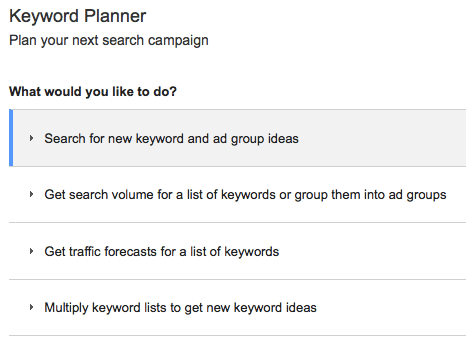Marketing Planning for 2015: How to Create a Content Calendar for Your Firm

Creating a content calendar is just one important aspect of your marketing planning for 2015. After you have a content strategy in place that addresses your services and key topic areas, it’s time to create a content calendar.
What is a content calendar and why is it important? A content calendar is a road map for your content marketing initiatives. It is (or should be) your marketing manager’s Bible. A shareable resource for your entire marketing team, you’ll stay on track and be able to plan content around significant events, conferences, and marketplace news.
Getting Started.
First thing’s first. Creating a content calendar requires, well, content—or ideas for content at the very least. Start by outlining your target audiences, keeping in mind that different posts will have different prospective audiences. Then, uncover their “pain points,” or the ongoing issues your prospects face.
After identifying your audiences’ pain points, build content around their needs and your services. Describe potential solutions to your prospects’ problems.
For example, if your firm helps organizations stay secure online, then a potential topic idea could be “Top 5 Ways to Keep Your Organization Secure from Hackers.” Take the pain point and write content that addresses the challenge.
If content creation still feels overwhelming, there are plenty of ways to farm existing resources for your blog. Here are a few ideas:
Organizing Content: Use What You’ve Got.
- Repurpose content. You’re likely sitting on plenty of content that you can repurpose. Take a whitepaper or article and make blog posts from the content – or vice versa. You’ll reach audiences that might otherwise miss out on the material.
- Interview experts. Know influencers and experts in your industry? Interview them! This will not only give your audience the benefit of external influencers’ insights, but your connection to this industry leader will help build your reputation and expand your connections.
- Case stories. You’ve got plenty of satisfied clients under your belt. Let this experience speak to your prospects. Case studies of solutions you’ve provided for current clients go a long way to winning new business.
- Keyword research. Once you have identified audience’s challenges, do additional keyword research to find related terms to write about. If you’re just starting out, try Google’s Keyword Planner. Keyword research will help you find other terms and phrases that may spark topic ideas or allow you to elaborate on an existing idea. You will also get an idea of how competitive the terms are and how realistic they are to rank for.
For example, if your firm provides wealth management software, you will find related terms that have reasonable search volume (the number of Google searches for the term):
- Investment management software
- Money management software
- Financial management
- Wealth management advisor
- Wealth management systems

After you have a solid selection of ideas and sources for content creation, it’s time to layout your plan.
Putting It All Together: Creating Your Content Marketing Calendar
1. Fill in the calendar with topics. Input the topic you’ve identified into your calendar. As you’re scheduling content, look at overlap with significant events. If an industry expert and your staff are both attending the same event, plan content—interviews, videos, conference recap etc.—around that event.
SEE ALSO: How to Incorporate Current Events into Your B2B Marketing Strategy
2. Identify the audience. As you populate your calendar, include the audience for which each piece is written. Most of your content will be aimed at groups of prospective clients, so you’ll want to tweak the content to appeal to those specific audiences.
Are you writing the blog post for a CTO to read? Or an IT director? Or an influencer at the organization? It may seem obvious as to whom the post is for, but including it on your calendar ensures you are addressing the right audiences with the right frequency.
3. Pace yourself. After your initial flurry of ideas, you might be eager to pack the upcoming weeks and months with lots of content. It’s better to realistic about your firm’s resources and how often you will be able to publish posts.
Write regularly rather than sporadically. Publishing a 500 word blog post every other week is more valuable than posting a 1500 word post once every six weeks. You can pick up the pace if you discover you have the time and topics to spare, but don’t promise your audience a post a week and not deliver. Which brings us to our last point…
4. Stay consistent. You might be one of the most reliable service providers in your field, but if your content marketing efforts are inconsistent, your reputation may suffer.
A content marketing calendar is a must for producing consistent content that addresses your audience’s challenges. Remember, your content is at the top of the sales funnel. A well thought-out calendar will keep your funnel full of quality web visitors, helping you generate leads and conversions across your online audience.
Find out more content marketing tips in our B2B Content Marketing Guide for Professional Services (it's free!).
On Google+ or LinkedIn? Follow us +HingeMarketing and join us on LinkedIn.

Industries & Topics
Most Popular
- Business Development Strategy: A High-Growth Approach
- A 10 Step Brand Development Strategy for Your Professional Services Firm
- Strategic Marketing for Professional Services
- Digital Branding for Professional Services
- 10 Essential B2B Marketing Strategies to Grow Your Professional Services Firm
- Digital Marketing Strategy for Professional Services
- Rebranding Strategies: A Step-By-Step Approach for Professional Services
- Elements of a Successful Brand 1: Brand Positioning
- The Top 5 Business Challenges for Accounting & Financial Services Firms
- Find Your Differentiator: 21 Ways to Gain a Competitive Advantage for Your Firm
- Elements of a Successful Brand 4: Brand Promise
- What Is the Cost of Video Production for the Web?





Leave a Comment